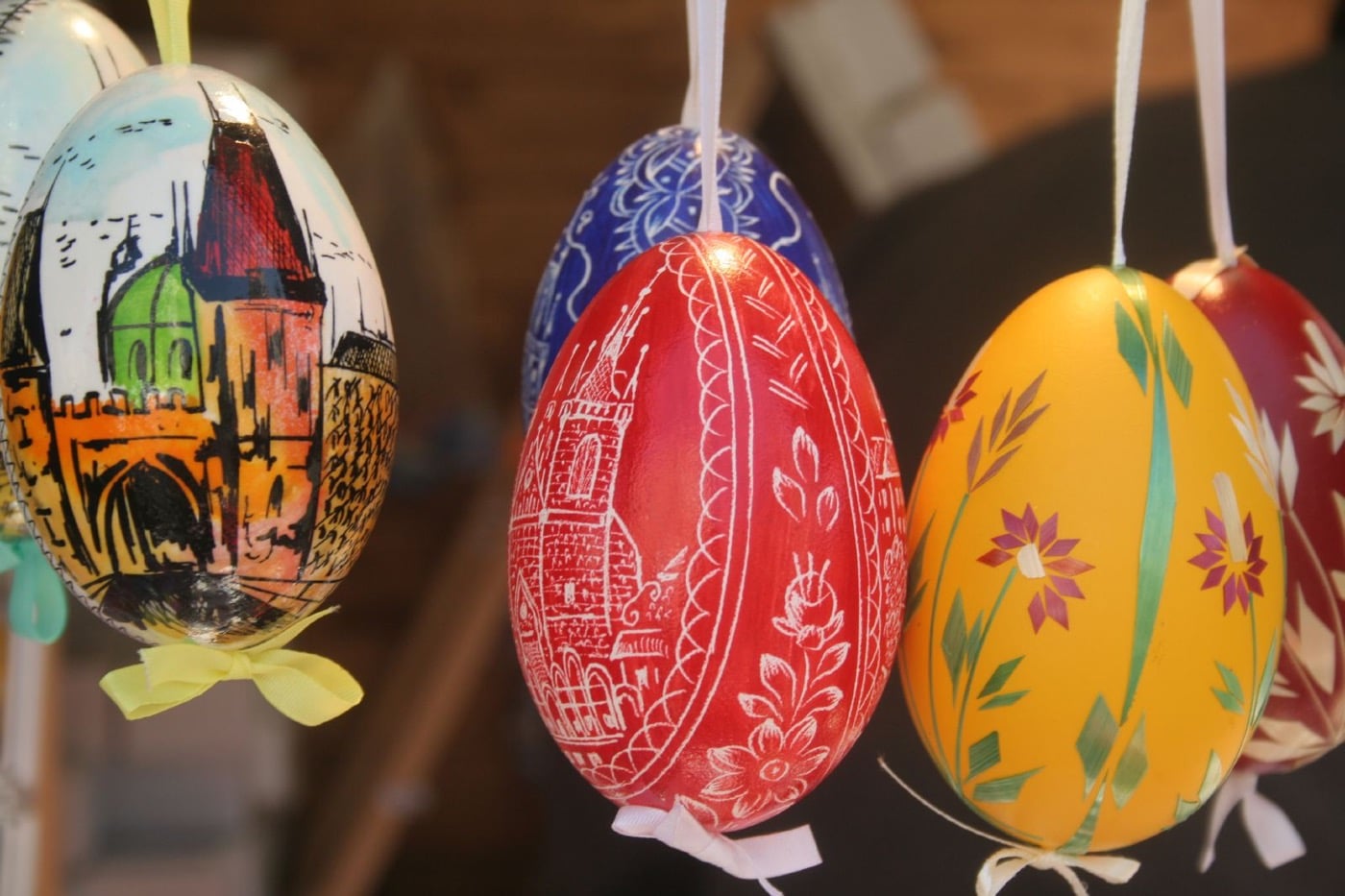It’s worth going to the Czech Republic just for the eggs. Not poached, fried, scrambled, or whisked into omelets. I’m referring to the beautiful colored eggs, decorated specially for Easter and sold year round at souvenir shops as lovely examples of Czech folk art.
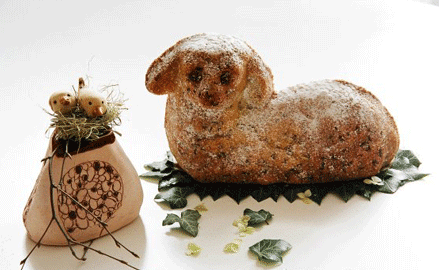
The decorating of eggs is a long-established Easter tradition in Central Europe, with roots dating far back into the pagan past. Archeologists in Europe have uncovered egg-shaped artifacts with ornate designs made thousands of years before the Christian era. Folklorists say that decorated eggs were part of pagan spring festivals, for which eggs were painted in bright colors to symbolize blossoming plants and the fertility of the season after the cold, dark winter. So it’s not surprising that the egg, representing the creation of new life, would also find a place in later religious celebrations of the resurrection of Christ.
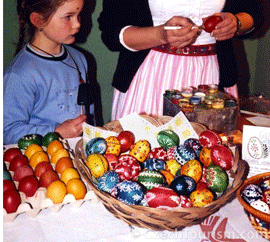
Today in the Czech Republic, highly decorated Easter eggs are known as kraslice, from an old Czech word meaning “beautiful.” And they’re beautiful indeed. Although some eggs are dyed solid red to symbolize the drops of Christ’s blood, most are decorated with geometric, floral, religious, or other symbolic motifs, using age-old techniques and patterns that vary from one region to another. A connoisseur of folk art eggs can tell at a glance which specific region of the Czech Republic that egg was made in.
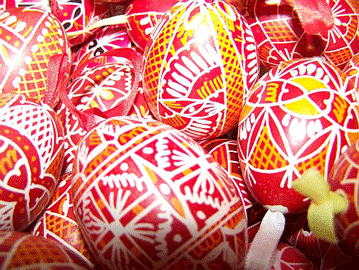
Chicken, duck, and goose eggs are all decorated for Easter. Some have the raw egg white and yolk blown out of the shell, through a small pinhole punched in each end of the egg. Others are uncooked eggs with their shells intact. (Over time, the raw egg inside dries up and helps protect the fragility of the thin shell.) Some of the most intricate designs are made using a labor intensive wax-batik method that requires plenty of skill, patience, and a steady hand, with the designs drawn on the eggshell with melted wax and the egg dipped into successive dye baths of red, yellow-orange, and black.
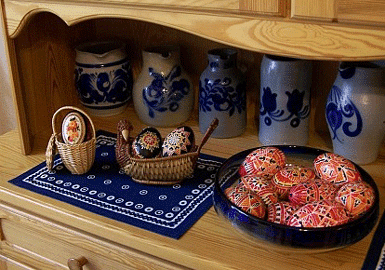
Some eggs are dyed a solid color—blue, purple, green, black—then part of the dye is scratched off with a needle to make fancy designs with the original white color of the eggshell showing through. Others are decorated with raised patterns of colored wax applied to the undyed eggshells, or with tiny pieces of straw, colored ribbons, dried flowers, beads, lace, or little colored paper ornaments glued onto the shells. Some eggs are even wrapped with thin wires twisted into intricate filigree motifs. And edible Easter eggs are now also crafted from chocolate, sugar, or marzipan—although these are considered a completely different category from the traditional decorative, symbolic kraslice made from real eggs.
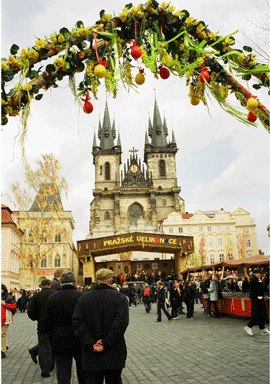
A charming Central European custom dating from the 19th century is the making of an “egg tree” at Easter. Long branches of budding pussy willow, harbingers of spring, are arranged in a large vase with decorated chickens’ or ducks’ eggs, brightly painted wooden eggs and sometimes little wooden birds hung on the branches like Christmas ornaments on an evergreen tree. In the weeks leading up to Easter, you’ll see these egg trees in many places, from hotel and restaurant lobbies to Easter markets and private homes.
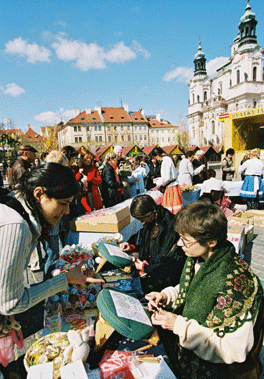
Czech eggs and pussy willow branches, along with traditional Czech Easter foods, can be found at the many Easter markets held around the country, usually during the last two weeks before Easter and sometimes for a week after Easter, too. The largest markets in Prague are located in the Old Town Square and Wenceslas Square, where you can also watch talented craftspeople decorating those pretty eggs. But if you have an opportunity to travel to Easter markets in smaller cities and towns throughout the country, you’ll encounter even more traditional crafts and foods, many of them unique to those particular places.
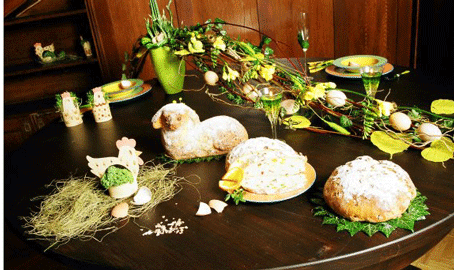
Czech Easter breads, cakes, and confections are also a big part of this holiday celebration, made with milk, butter, and eggs that were forbidden foods during the Lenten fast leading up to Easter. Many of these are formed into symbolic shapes, like the sweet raisin buns with crosses of bread dough on top; breads made from three braided strands of dough representing the Holy Trinity; and others made from twisted strands of dough representing the rope from which Judas, the betrayer of Christ, hanged himself. Gingerbread cookies are baked in the popular shapes of lambs, bunnies, and birds, often decorated with white or pastel icing. Homemade or bakery bought, these breads and cookies represent a continuity of traditions from centuries past, including much earlier, pre-Christian times.
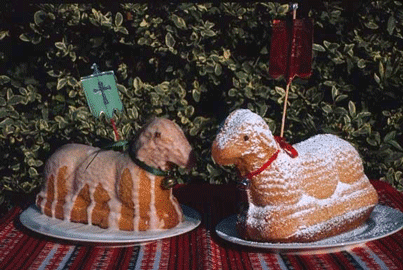
Look for the special cakes known as beránek, made from cake batter or sweetened yeast dough baked in three-dimensional metal or pottery molds shaped like lambs. Today these cakes represent Christ as the sacrificial Lamb of God, but their origin can probably be traced to pagan times, when baked dough effigies of animals were substituted for live animals in sacrificial rites. Some of today’s lamb cakes are dusted with a coating of confectioners’ sugar or drizzled with a light glaze of sugar icing. More elaborate ones are covered with fluffy white frosting, sometimes garnished with shredded almonds or coconut or spread with chocolate icing embellished with white icing swirls. The eyes are made from raisins, whole cloves, or coffee beans, and a small silk ribbon, often with a tiny bell attached, is tied around the lamb’s neck. Some of these lambs also have a branch of fresh rosemary (symbolizing remembrance) in their mouth, and many hold a colored foil banner bearing the emblem of a lamb or a cross, recalling similar banners carried by Christian crusaders to the Holy Land a thousand years ago.
Finally, don’t be surprised at some of the practices you’ll see on the day after Easter Sunday, which is a holiday in the Czech Republic and many other European countries. An ancient tradition is for boys to go around the villages on Easter Monday, lightly striking the girls’ legs with whips made from braided pussy willow twigs, or dousing the girls with water from buckets. In turn, the boys sing Easter carols at the girls’ houses and expect to be rewarded with a dyed egg and perhaps a colored ribbon to tie on their whips. Strange as all this may seem, these are the vestiges of pagan spring rites meant to chase away bad spirits, protect against illness, convey beauty and health upon the young girls who are the targets, and promote the fertility that the spring season brings. When you think about it that makes as much sense as believing in rabbits that suddenly show up on Easter morning with straw baskets full of those beautifully decorated eggs.
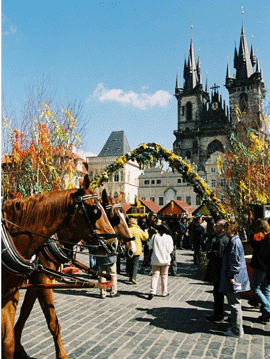
A visit to the Czech Republic during the Easter season won’t be soon forgotten. Easter is a moveable feast, often observed on different dates by Western (Catholic and Protestant) and Eastern (Orthodox) Christian churches, although this year Easter is on the same day for both branches of Christianity, April 20.
But whatever the year, Easter always occurs in March or April or sometimes early May, during shoulder season for most flights from the U.S. The summer tourist hordes haven’t yet arrived, the weather is warming up, and maybe, just maybe, you’ll find a beautiful Czech Easter egg hidden in the place you choose to visit. Veselé Velikonoce! Happy Easter!
Where to Find Out More:
http://www.stories.czechtourism.com
https://travelsquire.com/ts/czech-republic/stories/

